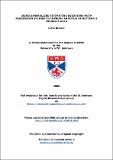Files in this item
Using generalized estimating equations with regression splines to improve analysis of butterfly transect data
Item metadata
| dc.contributor.advisor | Buckland, S. T. (Stephen T.) | |
| dc.contributor.author | Brewer, Ciara | |
| dc.coverage.spatial | 150 | en |
| dc.date.accessioned | 2008-05-19T08:23:37Z | |
| dc.date.available | 2008-05-19T08:23:37Z | |
| dc.date.issued | 2008-06 | |
| dc.identifier.uri | https://hdl.handle.net/10023/488 | |
| dc.description.abstract | Surveying animal populations is an important aspect of wildlife management. Distinguishing trend from random fluctuations and quantifying trend are key goals in any analysis. The aim of this thesis is to review analyses of Butterfly Monitoring Survey (BMS) data and to develop new methods which address some flaws in previous studies. The BMS was established in 1976 at Monks Wood, Cambridgeshire and sites were added over time throughout Britain in order to monitor butterfly population trends. Weekly counts are made over the monitoring season and the main aims are to produce annual indices and compare these indices over time for any particular species. Originally, weekly counts were summed to produce relative indices and missing counts were estimated using linear interpolation. This thesis discusses the weaknesses of this basic method and suggests possible improvements. In recent years, with advancements in statistical methods and increased computer power, new methods can be applied to accommodate the longitudinal and flexible nature of ecological data. Mixed Models, Generalized Estimating Equations and Generalized Additive Models are used and the relative merits of each modelling approach discussed. These methods allow for correlation and non-linearity in data. Model selection is an important consideration when modelling and different tests are introduced and compared. Once a model is selected, site-level indices are estimated, which can be collated to produce regional and national indices. Different methods of estimating precision around indices are also contrasted. Bootstrapping is found to be a convenient and dependable approach. Abundance is difficult to disentangle from detectability when only counts of species are carried out. Methods for dealing with this problem are suggested. Once reliable annual abundance estimates are found, they can be compared over time using a variety of statistical techniques. The chain-ratio method is applied to a subset of real data. | en |
| dc.format.extent | 692444 bytes | |
| dc.format.mimetype | application/pdf | |
| dc.language.iso | en | en |
| dc.publisher | University of St Andrews | |
| dc.rights | Creative Commons Attribution-NoDerivs 3.0 Unported | |
| dc.rights.uri | http://creativecommons.org/licenses/by-nd/3.0/ | |
| dc.subject | Butterfly transect data | en |
| dc.subject | Mixed models | en |
| dc.subject | Generalized estimating equations | en |
| dc.subject | Regression splines | en |
| dc.subject.lcc | QA278.2B84 | en |
| dc.subject.lcsh | Generalized estimating equations | en |
| dc.subject.lcsh | Regression analysis | en |
| dc.subject.lcsh | Animal populations--Mathematical models | en |
| dc.subject.lcsh | Butterflies | en |
| dc.title | Using generalized estimating equations with regression splines to improve analysis of butterfly transect data | en |
| dc.type | Thesis | en |
| dc.type.qualificationlevel | Doctoral | en |
| dc.type.qualificationname | MPhil Master of Philosophy | en |
| dc.publisher.institution | The University of St Andrews | en |
This item appears in the following Collection(s)
Except where otherwise noted within the work, this item's licence for re-use is described as Creative Commons Attribution-NoDerivs 3.0 Unported
Items in the St Andrews Research Repository are protected by copyright, with all rights reserved, unless otherwise indicated.


